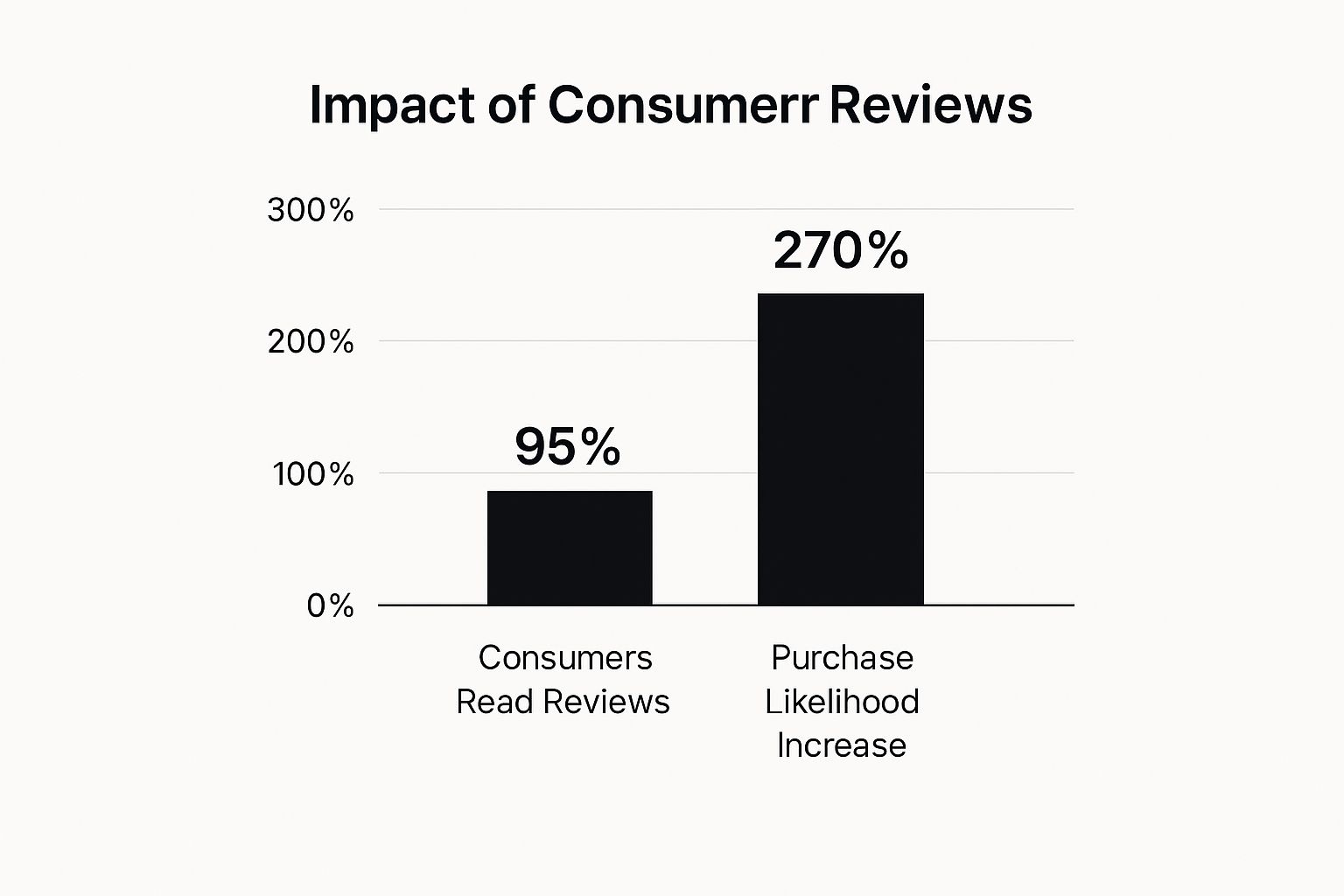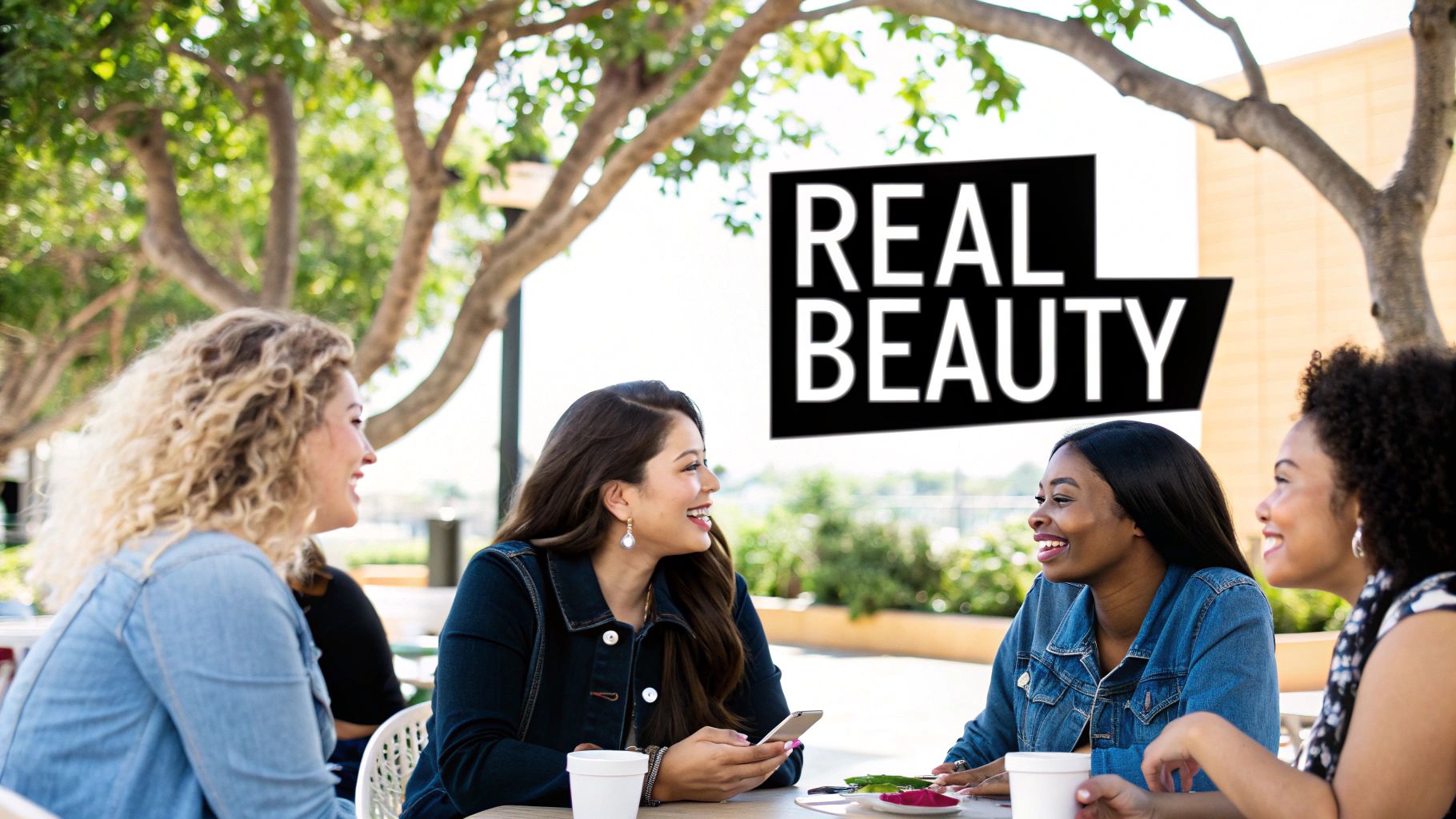
6 Powerful Example of Testimonial Advertisement Ideas (2025)
Discover the best example of testimonial advertisement strategies from brands like Nike & Slack. Learn how to replicate their success and create your own.
In today's crowded market, trust is the ultimate currency. While brands can shout about their features and benefits, a genuine recommendation from a happy customer cuts through the noise with unparalleled authenticity. This is the core power of testimonial advertising: using real human experiences to build credibility, forge emotional connections, and ultimately drive conversions. The most effective campaigns feel less like advertisements and more like trusted advice from a friend.
This guide moves beyond generic praise and dives deep into the strategy behind world-class testimonial ads. We will dissect six powerful examples of testimonial advertisement from brands like Nike, Slack, and Dove. For each one, we'll analyze the specific tactics that made it successful, from video production choices to the integration of customer reviews directly into the sales funnel. For a deeper dive into the effectiveness of real customer stories, explore how to create user-generated content ads that convert.
You will learn not just what these brands did, but why it worked and how you can replicate their success. We will provide actionable takeaways and strategic insights, showing you how to apply these lessons to your own marketing efforts. The goal is to equip you with a blueprint for creating compelling testimonial campaigns that resonate with your audience and deliver measurable results.
1. Nike's "Just Do It" Customer Athletes Campaign
Nike's "Just Do It" campaign is a masterclass in using testimonial advertising to build a brand identity that transcends products. Instead of focusing solely on the technical specifications of their shoes or apparel, Nike sells an aspirational identity. They achieve this by spotlighting the personal journeys of both world-famous athletes and everyday individuals, positioning them as "customer athletes" who overcome immense challenges, powered by their own determination and, implicitly, by Nike gear.
This strategy is not about a simple "I love these shoes" review. It's about crafting a powerful narrative of transformation and achievement. This is a prime example of testimonial advertisement because the story itself becomes the endorsement. The audience connects emotionally with the struggle and triumph, and that positive association is transferred to the Nike brand.

Strategic Breakdown
Nike’s approach is a brilliant fusion of inspirational storytelling and subtle product placement. They select individuals whose stories embody the "Just Do It" ethos, from Serena Williams' powerful comeback story to Colin Kaepernick's controversial stand for social justice. These are not just endorsements; they are cultural statements.
The campaign's genius lies in its emotional resonance and authenticity. By featuring a diverse range of voices, including local marathon runners in regional ads, Nike makes its aspirational message feel attainable to a broad audience. The focus is always on the human story, with the product playing a supporting, yet essential, role in the journey.
Key Insight: Nike sells a belief system, not just a product. The testimonials serve as proof that anyone, with the right mindset (and gear), can overcome their personal obstacles. This transforms customers from passive buyers into active participants in the brand's narrative.
How to Replicate This Strategy
While you may not have Nike's budget, the core strategy is highly replicable for businesses of any size.
- Focus on Transformation: Don't just ask for a review. Ask customers how your product or service helped them overcome a specific challenge or achieve a goal. Find the "before and after" in their story.
- Embrace Diversity: Showcase a wide range of customers. Feature different ages, backgrounds, and use cases to broaden your appeal and show that your product is for "people like me."
- Prioritize Authenticity: A raw, heartfelt story from a real customer often outperforms a polished, scripted ad. Encourage customers to share their experiences in their own words.
You can leverage ViewPrinter’s AI video tools to easily compile user-generated clips, add inspiring music, and overlay powerful quotes to create your own authentic, Nike-style testimonial video campaign. This approach helps build a community around your brand, united by shared stories of success.
2. Slack's Customer Success Story Videos
Slack excels at B2B testimonial advertising by shifting the focus from abstract benefits to concrete, problem-solving narratives. Instead of just saying their platform improves communication, they produce detailed video case studies featuring recognizable companies like Shopify, Airbnb, and IBM. These videos showcase real teams explaining precisely how Slack solved specific business challenges, boosted productivity, and delivered measurable returns.
This approach is a powerful example of testimonial advertisement because it provides social proof from respected industry players. Potential customers see a company similar to their own overcoming familiar obstacles, which makes the solution feel both credible and directly applicable. The testimonial isn't just an endorsement; it's a detailed blueprint for success that a new customer can envision for their own organization.

Strategic Breakdown
Slack's strategy is built on specificity and relevance. They don't just get a generic quote; they get key employees from companies like Shopify to walk through how Slack integrations reduced meeting times or how it enabled Airbnb’s global team to collaborate seamlessly while working remotely. This method directly addresses the skepticism inherent in B2B purchasing decisions.
The genius of this campaign lies in its focus on quantifiable results and relatable problems. By featuring well-known brands, Slack borrows their credibility. When a manager at IBM explains how Slack streamlined their enterprise-level communication, it immediately answers a key question for other large companies: "Will this work at our scale?"
Key Insight: B2B buyers respond to data-driven proof, not just emotional appeals. Slack’s testimonials act as mini-documentaries that prove the product’s value by showing, not just telling, how it solves critical business problems and delivers a clear ROI.
How to Replicate This Strategy
You don't need a client like IBM to make this strategy work. The core principle is about showcasing tangible results for a specific type of customer.
- Focus on Metrics: Ask your clients for specific numbers. How much time did they save? By what percentage did their productivity increase? How did it impact their bottom line? Data adds immense credibility.
- Feature Industry Leaders: Identify your most recognizable or respected customers, even if they are leaders within a small niche. Their endorsement carries more weight and provides valuable social proof.
- Address Common Objections: Structure your testimonial video to proactively answer common questions or doubts your prospects have. If they worry about integration, show how a customer managed it successfully.
You can learn how to create a video ad that follows this model using ViewPrinter. Its AI tools can help you interview clients remotely, edit their responses into a compelling narrative, and overlay graphics that highlight the specific metrics and KPIs they share. This turns a simple customer review into a powerful B2B sales asset.
3. Amazon Product Review Integration
Amazon transformed e-commerce by building its entire marketplace on a foundation of user-generated testimonials. Its sophisticated customer review system is a massive, living platform where millions of real purchasers share detailed experiences, photos, ratings, and even videos. This system has become the gold standard for social proof, directly influencing purchasing decisions across nearly every product imaginable.
This model is a powerful example of testimonial advertisement because it outsources trust-building to the customers themselves. Instead of a single brand message, potential buyers see a chorus of authentic voices, both positive and negative, creating a transparent and highly credible environment. The sheer volume and detail of these reviews, from an unboxing video of a new smartphone to a photo of a kitchen appliance in use, serve as a constant, evolving endorsement.
The following bar chart visualizes the immense impact of customer reviews on purchasing behavior, showing how deeply integrated they are into the modern consumer's journey.

The data clearly illustrates that reviews are not just a feature; they are a fundamental part of the sales funnel, with the potential to dramatically increase conversion rates.
Strategic Breakdown
Amazon's strategy democratizes the testimonial. It isn't about finding one perfect customer story; it's about building a system that encourages a high volume of authentic feedback. The platform's genius lies in its scale and accessibility. Features like "Verified Purchase" badges, helpfulness ratings on reviews, and Q&A sections add layers of credibility that a traditional, curated testimonial can't match.
The system works because it creates a feedback loop. Customers rely on reviews to make decisions, and because they benefit from the system, they are more likely to contribute their own feedback after a purchase. This constant flow of user-generated content keeps product pages fresh, informative, and trustworthy.
Key Insight: Trust is built through transparency, not just positivity. Amazon proves that allowing for a spectrum of feedback, including critical reviews, ultimately builds more consumer confidence than presenting only perfect, five-star endorsements.
How to Replicate This Strategy
You don't need Amazon's scale to build a powerful review-based testimonial engine. The core principles are applicable to any e-commerce business.
- Systematize the Ask: Implement automated post-purchase emails or messages that encourage customers to leave a review. Make it easy for them by providing a direct link.
- Encourage Visuals: Prompt users to upload photos or videos of their product in use. Visual proof is significantly more compelling than text alone.
- Engage with All Feedback: Respond publicly and professionally to both positive and negative reviews. This shows you are listening and value customer input, building trust with future buyers.
- Highlight the Best: Feature top reviews on your homepage, product pages, or in social media posts.
Leveraging these tactics is a cornerstone of a modern e-commerce content strategy on viewprinter.tech. Using ViewPrinter, you can collect video reviews from customers and easily compile them into a dynamic "wall of love" on your site, creating your own version of Amazon's powerful, customer-driven testimonial platform.
4. Dove's Real Beauty Campaign Testimonials
Dove's "Real Beauty" campaign fundamentally shifted the conversation in the beauty industry by replacing idealized models with authentic customer testimonials. The campaign features real women of diverse ages, sizes, and ethnicities sharing their personal beauty stories. This approach moved the focus from unattainable standards to relatable experiences, building a powerful emotional connection with its audience.
This strategy is a landmark example of testimonial advertisement because it turned the very definition of a "testimonial" on its head. Instead of a direct product endorsement, Dove facilitated a global conversation about self-esteem, where its products played a supportive role. The authenticity of these women's stories, from mothers discussing post-partum body confidence to friends sharing skincare journeys, became a testament to the brand's values.

Strategic Breakdown
Dove's strategy was to create a brand movement, not just an advertising campaign. By championing "real beauty," they tapped into a deep-seated frustration among women who felt misrepresented by mainstream media. The testimonials were not just about how a soap bar made their skin feel; they were about how the brand's philosophy made them feel seen and valued.
The brilliance of the campaign lies in its emotional connection and brand values alignment. Every piece of content, from short video interviews to print ads featuring groups of real women, reinforces Dove’s core message. They created a safe space for vulnerability, which in turn fostered immense brand loyalty and trust. This is a key reason why user-generated content (UGC) campaigns resonate so deeply; they are built on genuine human experience. You can see more powerful UGC video examples here.
Key Insight: Dove proved that a testimonial can be about a shared value system. By championing a cause their customers believed in, the products became a symbol of that cause, leading to sales driven by emotional alignment rather than functional benefits alone.
How to Replicate This Strategy
Your brand can adopt Dove's value-driven approach without a global marketing budget. The key is to find the emotional core of what you offer.
- Connect Product to Emotion: Don't just ask how customers use your product. Ask how it makes them feel. Does it give them confidence, save them time for family, or help them feel more secure?
- Champion a Cause: Identify a value that aligns with your brand and your audience. This could be sustainability, inclusivity, mental health, or community support. Build your testimonials around this shared value.
- Prioritize Raw Authenticity: Resist the urge to over-polish customer stories. The unscripted moments, genuine emotions, and slight imperfections are what make testimonials believable and impactful.
You can use a tool like ViewPrinter to collect video testimonials from customers who connect with your brand's mission. Compile these clips to create a powerful montage that showcases not just your product, but the community and values you stand for.
5. Airbnb Host and Guest Story Testimonials
Airbnb brilliantly addresses one of its biggest business challenges, trust between strangers, by using story-based testimonials from both hosts and guests. Instead of just showing five-star ratings, Airbnb builds compelling narratives around the connections, unique experiences, and sense of community fostered through its platform. These stories transform a transactional service into a deeply human experience.
This approach is a powerful example of testimonial advertisement because it tackles potential customer objections head-on. The stories of hosts welcoming travelers into their homes and guests discovering new cultures serve as powerful social proof. They build trust by showing, not just telling, that the platform is safe, reliable, and leads to unforgettable memories.
Strategic Breakdown
Airbnb’s strategy is rooted in showcasing the dual perspectives of its user base. By featuring both the host's pride in their unique space, whether a treehouse or a city apartment, and the guest's joy in discovering it, Airbnb creates a holistic and authentic picture. This two-sided storytelling reinforces the idea of a symbiotic community rather than a simple rental transaction.
The campaign's strength lies in its emotional relatability and specificity. A testimonial isn't just about a "nice stay"; it's about a family hosting an international student who becomes like one of their own or a business traveler finding a quiet, home-like retreat. These specific, heartfelt narratives make the abstract concept of "belonging anywhere" feel tangible and real.
Key Insight: Airbnb sells connection and unique experiences, not just lodging. The dual-perspective testimonials prove that the platform facilitates genuine human interaction and adventure, turning a potentially anxious decision into an exciting opportunity.
How to Replicate This Strategy
Even if your business isn't in the travel industry, you can adopt Airbnb's community-focused testimonial strategy.
- Showcase Both Sides: If you run a marketplace or a service that connects two parties (e.g., tutors and students, designers and clients), feature testimonials from both. This builds trust and demonstrates value for everyone involved.
- Highlight Unique Use Cases: Move beyond generic reviews. Encourage customers to share specific stories about how they used your product or service in a unique or memorable way. Did your project management tool help a nonprofit launch a successful fundraiser? Share that story.
- Address Concerns Proactively: Identify the biggest fears or hesitations your potential customers have. Then, find customer stories that directly counter those concerns. If customers worry about product complexity, feature a testimonial from a self-proclaimed "non-techy" person who found it easy to use.
With ViewPrinter, you can easily solicit video stories from different customer segments and edit them together into a single, compelling narrative. By combining clips from both a service provider and their client, you can create a powerful, Airbnb-style testimonial that showcases the value you create from every angle.
6. HubSpot Customer Success Hub Testimonials
HubSpot has transformed the B2B case study into a high-powered engine for trust and conversion. Instead of generic praise, HubSpot’s Customer Success Hub features incredibly detailed testimonials that read like strategic business blueprints. They go beyond simple satisfaction to document the entire customer journey, complete with specific metrics, implementation challenges, and measurable ROI.
This approach serves as a definitive example of testimonial advertisement for complex B2B products. By showcasing how companies like DoorDash scaled their operations or how Nextiva boosted lead generation by 400%, HubSpot provides tangible proof of its platform's value. The testimonial isn't just a story; it's a data-driven success case that speaks directly to the pain points of prospective customers in the competitive SaaS landscape.
Strategic Breakdown
HubSpot's strategy is built on providing irrefutable, data-backed evidence. They understand that a B2B buyer needs justification, not just inspiration. By detailing the exact problems a customer faced and the specific HubSpot tools they used to solve them, these testimonials function as both social proof and a practical user guide.
The genius of this method lies in its transparency and specificity. HubSpot doesn't shy away from discussing implementation hurdles or the learning curve. This honesty builds immense credibility and preemptively answers the nuanced questions that sophisticated buyers have. The focus is on quantifiable business outcomes, making the decision to purchase feel logical and secure.
Key Insight: For B2B audiences, data is the most persuasive form of testimony. Proving your value with hard numbers and detailed process breakdowns removes risk from the buyer's decision-making process and positions your brand as a trusted partner.
How to Replicate This Strategy
Even without HubSpot's resources, you can adopt their data-first approach to testimonials for your own B2B service or high-consideration product.
- Focus on Measurable Outcomes: Ask customers for specific KPIs. Instead of "it helped us grow," push for "it increased our lead-to-customer conversion rate by 35% in six months."
- Include Multiple Stakeholders: Interview different people from the client's company, from the end-user to the C-level executive. This provides a holistic view of your product's impact across the organization.
- Create Industry-Specific Content: Develop case studies tailored to different verticals. A success story from a similar company is far more compelling to a new prospect than a generic one.
You can use ViewPrinter to easily create video versions of these data-rich case studies. Animate key statistics, feature interview snippets from different stakeholders, and use on-screen text to highlight the problem, solution, and results. This transforms a static PDF into a dynamic and highly shareable sales asset.
6 Examples of Testimonial Ads Comparison
| Campaign / Example | 🔄 Implementation Complexity | 💡 Key Advantages | ⚡ Resource Requirements | 📊 Expected Outcomes | ⭐ Ideal Use Cases | |---------------------------------------|-----------------------------------------|---------------------------------------------------|----------------------------------------------|-----------------------------------------------------|----------------------------------------------| | Nike's "Just Do It" Customer Athletes | High: ongoing content, multi-platform | High emotional impact, strong brand loyalty | High production costs, continual creation | Consistent brand value growth, global brand leader | Consumer brands focusing on emotional stories | | Slack's Customer Success Story Videos | High: executive interviews, legal needs | Concrete ROI evidence, builds enterprise trust | Expensive production, legal agreements | 30% increase in enterprise sales conversion | B2B tech products, sales enablement | | Amazon Product Review Integration | Moderate: platform system integration | Massive scale, real-time trust building | Tech platform investment, community management| 95% consumers read reviews, 270% higher purchase likelihood | E-commerce platforms, product marketplaces | | Dove's Real Beauty Campaign Testimonials | Medium-High: diverse representation, consistent messaging | Authenticity, social impact, strong emotional connection | Photography, content coordination | 30% brand awareness increase, 700% sales growth | Beauty and personal care brands | | Airbnb Host and Guest Story Testimonials | Medium: ongoing global content creation | Builds trust, highlights unique experiences | Continuous content production, cultural sensitivity | Maintains 4+ star ratings, community growth | Peer-to-peer platforms, travel & hospitality | | HubSpot Customer Success Hub Testimonials | High: multi-stakeholder, data intensive | Quantifiable results, sales tool for enterprises | Complex production, customer cooperation | 25% higher close rate in enterprise sales | SaaS, CRM, enterprise B2B sales |
Create Your Own High-Impact Testimonials with AI
Throughout this article, we've dissected a diverse range of powerful testimonial advertisements, from the aspirational storytelling of Nike to the data-driven case studies of HubSpot. Each example of testimonial advertisement we explored reinforces a central truth: authenticity is the most valuable currency in modern marketing. Your audience craves genuine human connection, not slick corporate slogans. They want to see themselves in the stories of real people who have overcome challenges and achieved success with your product or service.
The common thread weaving through these campaigns, whether it's Dove's celebration of real beauty or Slack's customer-centric success narratives, is the strategic amplification of the customer's voice. They prove that the most compelling sales pitch doesn't come from a brand, but from a satisfied customer.
Key Takeaways for Building Your Own Testimonial Engine
Mastering the art of the testimonial advertisement no longer requires a blockbuster budget. The core principles are universal and more accessible than ever. To create your own high-impact campaigns, focus on these critical elements:
- Emphasize Transformation: Don't just show the result; showcase the "before and after." Highlight the specific problem your customer faced and detail the journey they took to a solution using your product. Airbnb excels at this by framing testimonials around the transformative power of travel and connection.
- Embrace Diverse Formats: A testimonial isn't limited to a single format. It can be a simple, powerful quote integrated into your product page like Amazon, a cinematic video series, or a detailed, data-rich case study. Match the format to the platform and your strategic goal.
- Let Your Customers Speak Naturally: The most resonant testimonials use the customer's own words. Avoid overly scripted or polished language. The raw, unvarnished honesty of a real user's experience builds immediate trust and credibility. Leveraging technology can significantly streamline this process; for instance, you can use a Testimonial Generator to help craft compelling customer stories from raw feedback.
- Quantify When Possible: While emotional stories are powerful, backing them up with concrete data creates an undeniable case for your product's value. HubSpot’s approach of showcasing specific metrics like "200% increase in leads" provides tangible proof that resonates with business-minded audiences.
By internalizing these strategies, you can begin to build a powerful engine of social proof that works for you around the clock. The goal is to move beyond simply collecting praise and start strategically deploying customer voices to address pain points, overcome objections, and inspire action at every stage of the buyer's journey. Each example of testimonial advertisement in this guide serves as a blueprint for turning authentic customer love into your most effective marketing asset.
Ready to turn your customer stories into high-converting video ads? ViewPrinter's AI-powered UGC ad studio makes it effortless to transform raw customer clips into polished, scroll-stopping testimonials for TikTok and Instagram. Start building your library of powerful social proof today and let your customers become your best advocates. Get started with ViewPrinter.